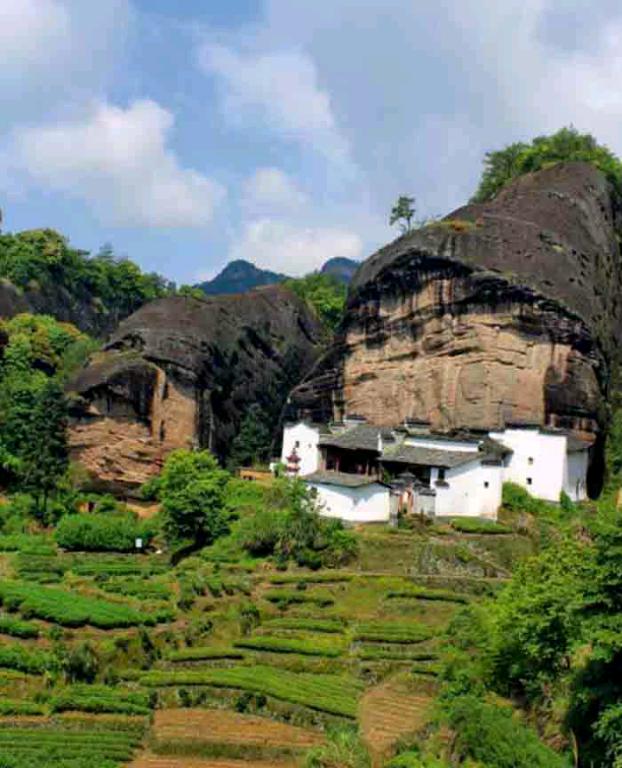Wuyi Mountains Rocking Tea
by+José+A.Morente+Pérez
Choosing a travel destination is never easy. The choice can be even harder within China, a land with endless places well worth visiting. Most have heard of the Forbidden City in Beijing, the Bund in Shanghai, the Terracotta Army in Xian, the karst landscape in Guilin, and the Sea of Clouds at the Huangshan Mountains. However, the Wuyi Mountains in Fujian Province have managed to stay below the radar of many foreign tourists.
In 2015, I moved to Fuzhou, capital city of Fujian Province. Renowned for its many tourist attractions, Fuzhou impressed me most with the beauty of its mountains and its local tea culture. In China, tea is divided into several categories includ- ing green, yellow, white and oolong. Four of them were invented by people in this southeastern coastal province. This testifies to how significant Fujian is to Chinese tea. Fujian features a rocky landscape and has a subtropical climate characterized by hot, humid summers and mild winters. This, alongside heavy rainfalls, frequently blankets the area in a green mist. However, a place within it is bursting with flora from the rocks: the Wuyi Mountains in the northwest tip of the province.
Its charcoal-colored peaks have been eroded by water for eons. Scratched steep cliffs appear like they were once cages for ancient massive beasts. The grass and trees struggle for a piece of land to put down roots. The fight for the precious and fertile land never stops in the Wuyi Mountains, nor does the incessant flow of mountain creeks and rivers. Most visitors to the mountains perceive a mysterious aura while admiring their spectacular precipitous rock landscapes. Usually covered by a thick layer of fog, it seems like time stands still here. The sound of gently flowing water, the wet black rocks, the fresh aroma floating in the air—all these things make this mountain range a magic place you dont want to leave, a place that is close but at the same time far away. Visitors are always enchanted by the spell of this place, the tranquil beauty of its dramatic gorges, the charm of its old temples, the joy of its flowery lands and the serenity of its paths… Its not surprising that UNESCO listed it as a World Heritage site back in 1999.
Over the last few decades, this land has seen an increasing number of visitors, especially artists of all types. They have started gathering here, seeking inspiration and seclusion. However, some artists have been living in this unique land since long ago: the Wuyi tea masters, who oversee tea production. The charm of the mountain range, coupled with the high quality of its water and fertile land, provides the locals with everything they need to produce one of the most admired tea categories in the world. An old Chinese saying goes: “Good mountains with good water produce great tea.” And so is the case in Wuyi. When you arrive, you will find it surrounded by numerous tea plantations, even in the most inaccessible places. The most famous variety of oolong tea produced here is known as “Wuyi rock tea.” Its name is inspired by the sandstone rocks of the Wuyi Mountains, from which it absorbs its unique flavor and fragrance.endprint
The human factor is critical to understanding Wuyi tea culture. The story of the Wuyi Mountains goes back ages.
The Wuyi Mountains tea plantations are most famous for Wuyi rock tea. But these planatations perhaps deserve more renown for the black tea that was first invented by local tea masters many years ago. Today, 75 percent of the tea consumed worldwide is black tea. The Wuyi Mountains played a key role in spreading this tea all around the world. It started during the 15th Century. The first to navigate a trade route to China to import tea were the Portuguese, who began shipping the leaves to Holland, France, and the Baltic. After Holland broke political ties with Portugal in 1602, the Dutch began importing Wuyi black tea to their own shores. This is how Wuyi black tea became popular among the European aristocracy and, little by little, across the European continent. After the success of Wuyi black tea, more and more tea farmers started producing black tea and selling it overseas, where its value was much higher than in the local market. Tea trade with European countries was crucial for the Chinese economy at that time. It was so important that the Qing Dynasty (1644-1911) banned exporting of tea plants to other countries so that foreign tea companies would have to be supplied by China. But this law did not stop a British botanist from smuggling tea plants from China to India, where tea began being produced in the British colony. Nowadays black tea is mainly produced in India, Sri Lanka and Kenya. Long gone are the days when the Wuyi Mountains were the dominant source of the global black tea market, but we should not forget that this mountain range still holds a very important position because Wuyi rock tea remains one of the most popular teas in China today.
A splendid history, charming landscapes and unique tea culture make a visit to the Wuyi Mountains highly recommended. I have visited the mountain range several times. Each visit, I find new things that make me come back again and again. You can take a bamboo raft down the Nine-Bend River as if you were traveling in an idyllic Chinese mountain and river landscape painting. Before leaving, make sure to enjoy some Wuyi rock tea while gazing over the rocky peaks.endprint

